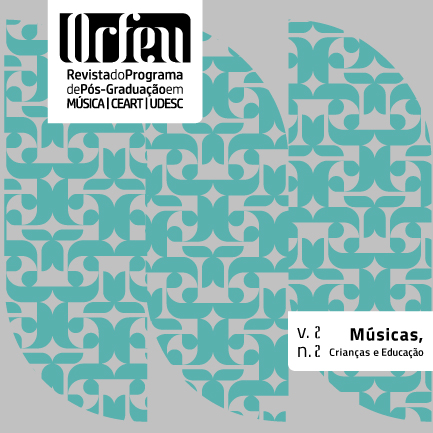Astonishing practices: a teaching strategy in music teacher education
DOI:
https://doi.org/10.5965/2525530402022017200Keywords:
teaching practice, observation techniques, teacher as researcherAbstract
This chapter by Fink-Jensen focuses on two key questions for the development of the pedagogical practice of music students in teacher education: how theory can contribute to the development of practice and how the relationship between theory and practice can be addressed during their education. Regarding the teacher as a researcher she proposes the implementation of a teaching strategy that she called "astonishing practices", relying on anthropological and phenomenological concepts as well as on theories from the field of psychology, pedagogy and music education. The central point is the identification of a problem situation, thus it is essential that the student is able to observe in an open-sensuous way, leaving already established theoretical premises behind so that the student can generate new possibilities for such a teaching situation.
Downloads
References
FIELD, James C.; LATTA, Margaret A. Macintyre. What constitutes becoming experienced in teaching and learning? Faculty Publications: department of teaching, learning and teacher education, 2001. Disponível em: <http://digitalcommons.unl.edu/teachlearnfacpub/5>. Acesso em: 17 de Setembro de 2012.
FINK-JENSEN, Kirsten. Attunement and bodily dialogues in music education. Philosophy of Music Education Review, n. 15, v.1, p. 53-68, 2007.
GLEITMAN, Henry; FRIDLUND, Alan J.; REISBERG, Daniel. Psychology. New York: W. W. Norton, 1999.
HAAVIND, Hanne (Ed.). Kjønn Og Fortolkende Metode: metodiske muligheter i kvalitativ forskning. Oslo: Gyldendal Akademisk, 2000.
HARGREAVES, David J. The Developmental Psychology of Music. Cambrige: Cambrige University Press, 1986.
IMSEN, Gunn. Lærerens Verden: innføring i generell didaktik. Oslo: Tano Aschehoung, 1997.
JARVIS, Peter. The Practitioner-Researcher: developing theory from practice. San Francisco, CA: Jossey-Bass, 1999.
KVERNBEKK, Tone. Pedagogisk Teoridannelse: insider, teoriformer of praksis. Bergen: Fagbokforlaget, 2005.
KVERNBEKK, Tone. Seeing In Practice: a conceptual analysis. Scandinavian Journal of Educational Research, n. 44, v. 4, 358-370, 2000.
KVERNBEKK, Tone. Teorityper og bruk av teori. In: NIELSSEN, Frede V.; JØRGENSEN, Harald (Eds.). Nordisk Musikkpedagogisk Forskning årbok 5. Oslo: NMH-publikasjoner, Norges Musikkhøgskole, p. 25-42, 2001.
LYLE, John. Stimulated Recall: a report in its use in naturalistic research, British Educational Research Journal, n. 29, v. 6, p. 861-878, 2003.
NIELSEN, Frede V. Almen Musikdidaktik. Copenhagen: Akademisk Forlag, 1998.
ROBERTS, Brian. Music teachers as researchers, International Journal of Music Education, n. 23, v. 1, p. 24-33, 1994.
RØNHOLT, Helle. Didaktiske irritationer. In: RØNHOLT, Helle; HOLGERSEN, Sven-Erik; FINK-JENSEN, Kirsten; NIELSEN, Anne Maj (Eds.). Video i Pædagogisk Forskning: krop og udtryk i bevægelse. Copenhagen: Forlaget Hovedland, p. 106-153, 2003.
RØNHOLT, Helle; HOLGERSEN, Sven-Erik; FINK-JENSEN, Kirsten; NIELSEN, Anne Maj. Video i pædagogisk forskning: krop og udtryk i bevægelse. Copenhagen: Forlaget Hovedland, 2003.
SHWEDER, R. A. Thinking Through Cultures: expeditions in cultural psychology. Cambrige, MA: Harvard University Press, 1991.
ZAHAVI, Dan. Beyong Empathy: phenomenological approaches to intersubjectivity, Journal of Consciousness Studies, n. 8, v. 5-7, p. 151-167, 2001.
ZAHAVI, Dan. Fænomenologi. Copenhagen: Roskilde Universitetsforlag, 2003.
Downloads
Published
How to Cite
Issue
Section
License
Copyright (c) 2017 ORFEU

This work is licensed under a Creative Commons Attribution 4.0 International License.
Authors who submit their manuscripts to be published in this journal agree to the following terms:
1. Authors retain the copyright and grant to the journal the right of first publication, whilst simultaneously permitting their work to be licensed under the Creative Commons License Attribution, which allows the sharing of work with recognition of the authorship and initial publication in this journal.
2. Contributions in this journal are open access; this means they are based in free use, and non-commercial applications.






